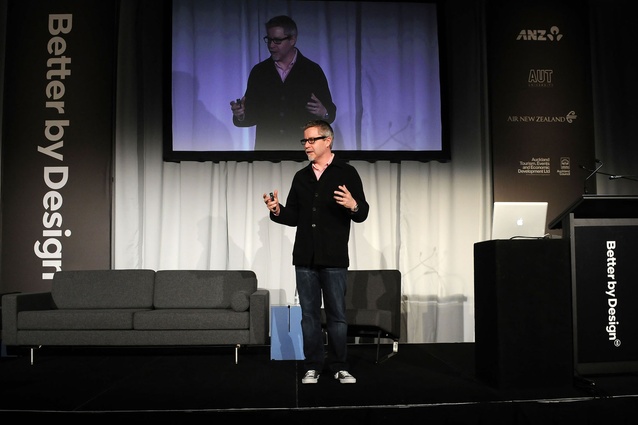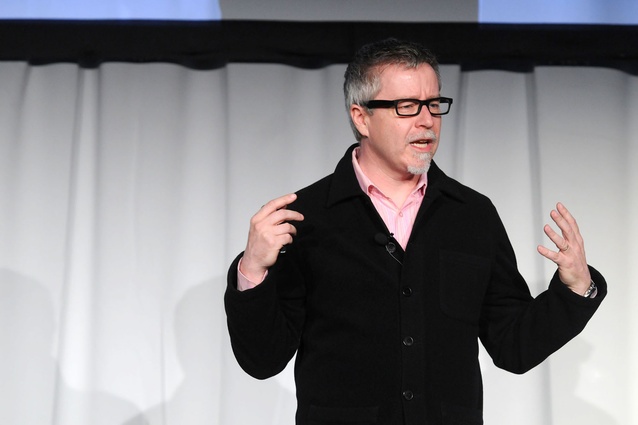Inspiring ideas at Better by Design
Tim Brown is the CEO of IDEO. Ranked independently among the 20 most innovative companies in the world, IDEO is the design consultancy that contributed to such standard-setting innovations as the first mouse for Apple, the Palm V, and Bank of America’s ‘Keep the Change’ service. Tim’s ideas and experience are widely sought in industry, academia, and the non-profit community. He has led strategic client relationships with such companies as Sony, Microsoft, Motorola, Pepsi, Procter & Gamble and Steelcase. An industrial designer by training, Tim has a special interest in the convergence of technology and the arts, as well as the ways in which design can be used to promote the well being of people living in emerging economies. See more about Tim and other speakers from NZ Trade and Enterprise’s Better by Design CEO Summit.
Urbis: Can you sum up your central idea that you spoke about at Better by Design?
Tim Brown: The central thesis is, we built our approach to design based on designing fairly simple things – products, maybe buildings. And we’re trying to apply those same approaches to design questions today that are orders of magnitude more complex than that.
And I don’t think that works very well. Its not that design doesn’t work, it’s not that design at that small simple scale isn’t still very effective, it is. But there are some other things I believe we need to think about once we start to get to the large and complex. And so, and the reason why I think we need to tackle large and complex things in a more intelligent way is because otherwise the shear volatility of the world will be impossible to deal with – for business, for society, for individuals.
Out of that comes a whole set of series which are essentially based on how biological systems work and how evolution works. By understanding the differences in scale and doing small things repetitively can lead to big scale, or to do with thinking about the behaviour of a system rather than the physical artifacts of a system. This has to do with how you code behaviour, how do you get behaviours through code not through stuff.
U: One of the things I thought was interesting when you were talking yesterday was that you started your conversation by saying, ‘This is a new idea that I’m just coming up with and it could be totally wrong’. It struck me that it was important to you to be open to the possibility of being wrong or having differing opinions. How is that central to what you’re doing?
TB: In some ways, as the thesis itself was about not assuming that you can know and plan everything, it felt reasonable to say I don’t think I can know and plan everything and therefore I’m open to this being wrong, so that was part of the reason.
But also, I’ve just found that this has been the case over and over again that ideas get stronger as people talk about them and discuss them. And instead of me delivering this plan that says this is the way the world is, well I think these things might be interesting what do you think, and you get much more interesting feedback that way and you build on the ideas. I’ve already had some really interesting feedback from people just in the last day. It just seems the smart way to build. I’m actually pretty excited about this and I think this actually pretty important and I think it quite probably has got some rightness or truth to it.
U: I think when people start talking creativity, there are a lot of people who never took art classes at school and just don’t put themselves into a box that they’re creative, they divide those who are creative from those who aren’t. How do you start instilling this idea of creativity in people who don’t consider themselves creative?
TB: You have to take the fear away, that’s the most important thing. People are scared of doing creative things, partly because they don’t believe they’ve got the technical and physical skills. Anybody would be scared about the idea of picking up a violin and playing it if you don’t have the technical skills to play the violin. They are also scared of giving themselves permission to have ideas, to imagine new things. That bit you can do something about. You can do something about skills too, but it takes practice. But there are forms of creative expression that don’t necessarily require all of the skills or it may be that some of the team members have to have the skills and not everybody does. But you can do something about that fear of imagination.
And as other speakers have talked about over the last couple of days, as kids, none of us had fear of imagination, it was instilled in us either through peer pressure or through the education system. Some people were lucky enough to have more than their fair share of a natural desire to express themselves creatively and either broke through that or showed certain skills that meant that they followed that direction and a lot of us went down the path that I went down and went to art school and we showed that in some way and it became our preferred direction. I honestly don’t believe that there is anybody on the planet that can’t express themselves creatively if you take that fear away and give them some of the basic concepts of how they might do that. For me the proof of that is, I look at people who you would generally think of as not being creative, some of the most brilliant scientists in the world and I see them as being intensely creative. I was recently hanging out with one of the recent Nobel prize winners from Berkeley and he’s a brilliant physicist and a genius violinist – he’s incredibly creative and he’s one of the best scientists in the world. And so if it works for them, I’m pretty sure it works for everybody else.
U: Maybe you could explain a bit more about your role and what IDEO works on and how you work in business. Why would someone come to you and how would you approach that?
TB: Businesses and institutions come to us for a number of different reasons. Often they come because they don’t know what questions to ask, they don’t know what they should be focusing their innovation efforts on. So they’ll come with some form of, ‘help us figure out what we should work on’, and very often that will be the beginning of the journey which then is ‘well here’s what we think we should work on and together we’d figured out what those opportunities are’ and the next question, ‘well can you help us work on it?’ Can we do something with that set of opportunities?
And some businesses come saying, ‘well we know what we want to work on, but can you help us work on it’. Others come and say, its actually not about the questions we’re going to ask or what we’re going to work on, we need our own organisation to be more innovative and have more creative capacity, how can you help us, how can you give us the tools to do that? Its some combination of those three questions most of the time. That’s from almost every business sector – from highly technical like telecommunications, computing, media, medical systems and equipment, right across all consumer products sectors, transportation, travel, right through to government and to services and systems and processes to do with service business. It’s a very broad range. I think the thing we often find most rewarding is while we have impact in the world we see, we help organisations go and do something useful with design and innovation, which is what motivates them and the other second hand, we just get to work on some really cool stuff.
U: So what it is about design thinking that is unique? Why are traditional businesses trying to adopt it?
TB: I think the way I would describe it and many others would describe the same thing, is that business has overly emphasised the role of analytical thinking. The best way I would describe that is using the past to predict the future, and assuming that the future is based on making a choice out of a set of existing alternatives. I use the term ‘design thinking’ to describe the other half of that which is let’s create the future by imagining the future, and lets see if we can’t put the neutral issues on the table that have never been there before. So it’s a sort of divergence process before convergence. Where as, the conventional analytical approach to business is all convergence: ‘I’ve got this issue, I see these choices, I make that one and we’re going to look forward.’
[In the Better by Design conference] Dev Patnaik was talking about empathy, because of the nature of design it instills in an organisation a set of capacities that are highly useful in many, many different ways. They develop the service of their innovation, things like, really understanding the world in which you do business and the consumers and customers which you provide for or understanding how to create and make and learn from the makings – its a whole prototyping process, that instead of sort of inexorable planning and that many analytical organisations go through with the assumption that you’ll get a perfect plan and you’ll execute it and you’ll have a perfect outcome which of course never works because the outcome, is never what you thought it would be.
This idea of ‘building to think’ or ‘learning with your hands’ as it were and in a capacity which serves an organisation well, not just in its ability to innovate but in the way it behaves and does other things. And then there are other things like storytelling, for instance. Creative organisations are great storytellers and stories are great ways of transmitting values, great ways of transmitting purpose, great ways of communicating with customers, again not just at the service of innovation, but focusing on it around innovation helps you build that capacity.











